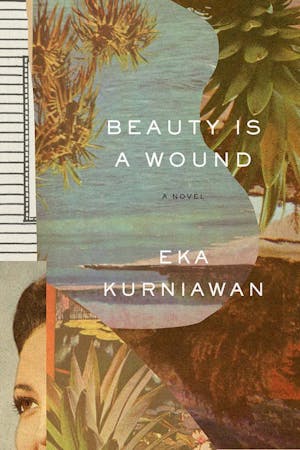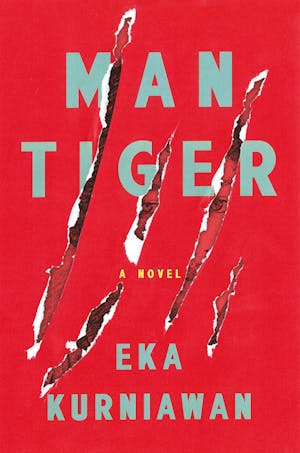Three-quarters of the way into Beauty Is a Wound, the sprawling, ambitious novel by the Indonesian writer Eka Kurniawan, there is a curious scene at a cemetery. A man has just been buried there, a Communist killed in the civil war erupting throughout the country in the mid-’60s, and his daughter Farida refuses to leave the site of his grave. She attracts the attention of Kamino, the lonely cemetery caretaker whose skills, along with interring the dead, include an ability to raise them back up through a practice called jailangkung. Entranced by Farida, Kamino offers to contact her father’s spirit, and the young woman ends up staying with him even as fresh corpses are brought in from what has turned into a one-sided massacre. Eventually, there are so many bodies that Kamino has to resort to mass burials, but this does not interrupt his growing romance with Farida. Kamino calls up the spirit of the dead Communist every evening, who, taking possession of Kamino’s body, chats with Farida, “as if it was just like any other night … as if death didn’t exist.”
There is much dying in the novel, for major characters, for supporting figures, for wild boars and for wild dogs, but death usually offers no finality. Corpses are dug up, cross-dressed, and put on motorcycles. Communist ghosts lurk everywhere, so that when an elderly Dutch couple visits a decade after the civil war and learns about them, the man retorts, “Karl Marx already warned us about that in the first paragraph of his Manifesto.” Then there is the central character of the novel, the beautiful and enterprising prostitute Dewi Ayu, who is introduced to us in this fashion in the opening lines: “One afternoon on a weekend in March, Dewi Ayu rose from her grave after being dead for 21 years. … She had passed away at 52, rose again after being dead for 21 years, and from that point forward nobody knew exactly how to calculate her age.”
Does death exist in the realm of Kurniawan’s fiction or not? Told by an omniscient narrator, jumping back and forth across an Indonesian twentieth century that includes the final stage of 300 years of Dutch colonialism, the Japanese invasion during World War II, the liberation struggle and decolonization after the war, internal tensions, rebellions, a genocidal massacre in the mid-’60s, totalitarian rule for three decades, and the bloody occupation of East Timor, Beauty Is a Wound is full of dead people who nevertheless refuse to vanish.

Translated into English for the first time, Beauty Is a Wound is a novel making a claim about capturing a nation, its resurrection of Ayu a prologue to Kurniawan’s depiction of the coming of age of Indonesia as a modern, twentieth-century entity cobbled together out of more than 17,000 islands, 700 languages, and with the largest Muslim population in the world as well as significant minority populations of Hindus, Buddhists, and Christians. This transformation of many cultures into a nation is also the focus of Man Tiger, Kurniawan’s other work to appear in English, even if this latter book is written in a contrasting style, just as taut and lean as Beauty Is a Wound is sprawling and capacious. Its focus is for the most part on a young man called Margio who lives in a small, unnamed village on the Indian Ocean, a place far from the metropolitan centers and seemingly cut off from the excesses of history. But just as Beauty Is a Wound uses Ayu’s resurrection as an opening move for the exploration of a nation, Man Tiger begins with an equally dramatic incident that will also have to be unpacked for its larger, societal meaning. This is the brutal killing of a middle-aged playboy named Anwar Sadat (not the assassinated Egyptian president), whose throat is ripped out by Margio. As we read on, we learn the killing has really been carried out by a magic tigress, “white as a swan or a cloud or cotton wool,” who has come to live inside Margio, a creature connected to the past of Margio and his people.
The feisty, opinionated, and resourceful Ayu embodies the intersection of past and present in a different manner. Born into a family of Dutch plantation owners but with a native woman as one of her grandmothers, Ayu grows up a privileged young woman in the fictional port town of Halimunda. But her colonial entitlements are brutally swept aside by the Japanese occupation, and she is imprisoned and forced into prostitution. Nevertheless, as Ayu remakes herself into the most desired prostitute in Halimunda in the decades after decolonization, she becomes the moral center of the novel, capable of humanity, wisdom, and joy even as the world around her turns dark and bloody.
Ayu is mother to four daughters, Alamanda, Adinda, Maya, and the eponymous Beauty. To these daughters are drawn the men who will determine the bloody course of nationhood and modernity in Halimunda: the violent former guerrilla and military commander Shodancho, who forcibly takes Alamanda as a wife; Maman Gendeng, a martial arts fighter and gangster who is first Ayu’s lover and then Maya’s husband; and Comrade Kliwon, a leader of the fishermen’s trade union loved by Alamanda, loathed by Shodancho (who runs giant mechanized fish trawlers), and married to Adinda. From these pairings come the children who form the final generation of the novel, who are no more free of ghosts than previous generations, as Ayu realizes on her return from the grave.
Beauty Is a Wound was first published in Indonesia in 2002, at the beginning of a period of national reckoning that started with the downfall of the dictator Suharto in 1998. The arrival of the novel’s English translation some 13 years later marks another point in this process of coming to terms with what was one of the cold war’s largest and yet most obscure atrocities. Between 500,000 and two million members and sympathizers of the Indonesian Communist Party were killed from 1965 to 1966, butchered by army squads, vigilante gangs, and Islamist groups. An estimated 750,000 more were imprisoned and tortured, among them Indonesia’s best-known writer, Pramoedya Ananta Toer, who orally composed his anti-colonial quartet of novels in the notorious Buru prison and whose works remained banned for almost his entire lifetime.
The event that provoked the massacre, the killing of six generals by a group of supposedly leftist officers was, Cornell scholar Benedict Anderson suggests, a setup by Suharto, at the time an army general. Suharto used the army’s newspapers to print fictitious accounts of the sexually deviant acts committed by women members of the party with the corpses of the slain generals (and who would later make the viewing of a slasher-style film version of this compulsory in Indonesia) and unleashed what turned out to be a phenomenally successful mass-extermination campaign, eliminating the Indonesian Communist Party from the political landscape and deposing the president, Sukarno. Once he had installed himself as leader and was established as a close ally of the United States, Suharto remained in power until the reverberations of the Asian currency crisis in 1997 and massive protests against him brought an end to his one-man rule a year later.
In the aftermath of Suharto’s exit, stories of the massacre have begun to reassert themselves in the manner of Kurniawan’s restless ghosts and magical tigers. In the West, such remembrance has been provoked by the documentary The Act of Killing (2012), directed by the American filmmakers Joshua Oppenheimer and Christine Cynn, and an anonymous Indonesian filmmaker, which tracks a group of vigilantes as they reenact their brutality for the camera. This has been followed by The Look of Silence (2014), focusing on a relative of one of the victims.
In Indonesia, efforts to recall and mourn the past have included the publication, in 2012, of a report by the Indonesian Human Rights Commission on the army’s role in the killings; attempts at reconciliation by individual members of a Muslim mass organization also implicated in the slaughter; and screenings of the two documentaries made by Oppenheimer.
Kurniawan’s political awakening seems to have proceeded in step with this larger process and worked its way into his books. A philosophy student from a provincial background at the Gadjah Mada University in the city of Jogjakarta, he was radicalized as a thinker and writer while throwing stones against the police in the anti-Suharto protests of the late ’90s and the clandestine dissemination, by a semiunderground left party, of Toer’s banned Buru quartet novels. He would go on to write his dissertation on Toer, which was rejected by his university faculty review committee when he first presented it in early 1998 because Toer was a dissident figure but easily approved when he submitted it again after Suharto’s ouster.
Nevertheless, when it came to artistic practice, Kurniawan clearly wanted an approach other than Toer’s, with its accumulation of details and its steady, linear narrative. So while Toer’s quartet is comprehensive in nature, each novel building upon its predecessor, Beauty Is a Wound depends heavily on sudden shifts in time and scene. Moreover, from its opening line, reminiscent of the flashback-flash forward disorientation of the famous first sentence of Gabriel García Márquez’s One Hundred Years of Solitude, its use of the fictional realm of Halimunda to tell the story of a nation, its powerful female characters, and its identification with the underclass being swept aside as brutally by despotic nationalism as it was by old-school colonialism, Kurniawan’s novel seems far closer to the tradition of Latin American magic realism of the “Boom” era of the 1960s and ’70s than to Toer’s writing.
But if magic realism is all there is to Beauty Is a Wound, there would be something anachronistic about it, as if Kurniawan, unaware of the evolution of the novel elsewhere, had been working away in a literary Madagascar. He was born in 1975, almost a decade after the publication of One Hundred Years of Solitude, and there is reason to see influences that are much more contemporary. An energetic blogger, Kurniawan has written about the close affinity he feels with the Chilean novelist Alejandro Zambra, who portrays a Chile that traveled a path very similar to Indonesia’s, where the army general Augusto Pinochet followed up a CIA-backed coup with the torture and killing of leftists and heavy doses of neoliberal economics.
Beauty Is a Wound wants, at one level, to remember what happened and, in the process, restore dignity to those tortured and killed. Yet in spite of the immense brutality depicted in the novel, there are no one-dimensional oppressors, not the Dutch, not the Japanese, and not even the cold, violent Shodancho, who directs the anti-Communist massacre in Halimunda and is a rapist many times over. This is less a matter of the psychological complexity of the characters and more an aspect of the novel’s plot, which periodically introduces a new twist into the story and forces a fresh response from the characters. An oppressor can become a victim from such a turn of events, or a playboy an activist. It is not hard to see, in such morphing of story and character, the wide-ranging influences behind Kurniawan’s fiction, including the West Javanese ones identified by Annie Tucker, the translator of Beauty Is a Wound, who writes that it draws from “the bawdy wit and epic scope of wayang theater; the folk tales for which the region is famous; and Indonesian horror and martial arts genre fiction.”
Kurniawan’s blog reveals a voracious reader who forages far and wide in the manner of an autodidact blissfully free of the derivative cultural norms popular among non—Western national elites or the regimented aesthetic ideas promoted by Western creative writing programs. He writes that he leapt from reading Indonesian pulp fiction in his childhood to devouring a world canon of Toni Morrison, Salman Rushdie, García Márquez, Knut Hamsun, and Dostoyevsky. One can see something of both realms in Beauty Is a Wound, from its surprising leaps in plot and bursts of comedy to its ambition in depicting the making and unmaking of a nation.

That wide range of reading might also explain the testing, experimental nature of his writing and how Man Tiger, at least formally, is so different from Beauty Is a Wound. If the latter is an epic novel, the former gives the impression of being built upon a close observation of life in the provinces, where the young men are migrant workers in the cities and the women they court pine away for their letters and go every Monday to the village hall for the weekly arrival of the postman. The houses and huts are small, the people all known to one another, but the rural characters possess a stark grandeur and take on a disturbing familiarity as the narrative begins to linger over scenes of killing and a burial gone horribly wrong.
Here, too, in a place seemingly far removed from the tremors of history, are the ghosts of Indonesia’s bloody past. We see, as the story falls back in time from its dramatic opening, Margio’s growing rage as he, his sister, and their mother, Nuraeni, are subjected to terrifying violence by Komar bin Syueb, the barber who is Margio’s father. This is followed by the deft seduction of Nuraeni by Sadat, in whose house she works as a maid. As in Beauty Is a Wound, Kurniawan is exceptionally sensitive to women and children trapped in a brutal, self-interested patriarchal world and one feels, in the frustration and heartbreak of the moody Margio, in his growing anger at his father and Sadat, an indictment of an entire generation of violent patriarchs—Suharto and his henchmen—who handed out suffering to those they claimed as their own.
It is easy to think that the novel, whether representing the coming of age of a character or of a nation, is bound to follow the bourgeois European model of bildung, or education, with protagonists finding calm and acceptance after their growing pains, and with nations reaching the flatland of the end of history after theirs. What Kurniawan suggests is that this is a false model for much of the world and that the past is not over and done with quite so easily. In that sense, both Man Tiger and Beauty Is a Wound constitute a retort from the present to the dark times, while also acknowledging that the dark times may not yet be over. Against the killings of those years and the collective amnesia used to blank out the fate of the victims—a kind of second death, as it were—Kurniawan’s fiction summons its legions of ghosts. Against the strongmen who presided over violence and abuse, it raises the dead Dewi Ayu and brings to life a magic tigress hungry for justice.
